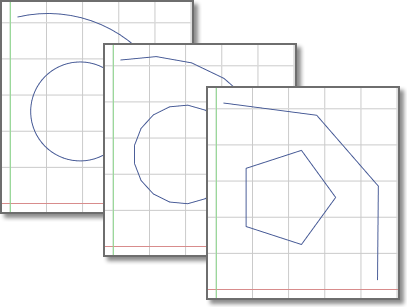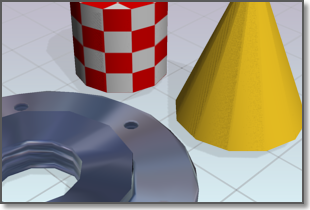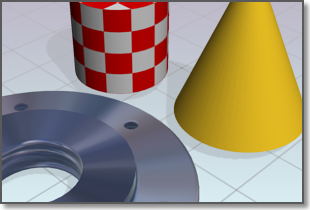When you render a model, the density of the mesh affects the smoothness of surfaces.
Mesh components are comprised of vertices, faces, polygons, and edges.
In a drawing, all faces have three vertices, except faces in polyface meshes, which are treated as adjoining triangles. For rendering purposes, each quadrilateral face is a pair of triangular faces that share one edge.
Smoothing of an object is handled automatically by the renderer. Two types of smoothing occur during the rendering process. One smoothing operation interpolates the face normals across a surface. The other operation takes into account the number of faces, the face count, that make up the geometry; greater face counts result in smoother surfaces but longer processing times.
While you cannot control the interpolation of face normals, you can control the display accuracy of curved objects by using the VIEWRES command and the FACETRES system variable.
Control Display of Circles and Arcs
The VIEWRES command controls the display accuracy of curved 2D linework like circles and arcs in the current viewport.
In the following example, line segments are more apparent as VIEWRES decreases - Upper left = 1000, Middle = 100, Lower right = 10.

These objects are drawn on the screen using many short straight line segments. Smoother arcs and circles display with higher VIEWRES settings, but they take longer to regenerate. To increase performance while you're drawing, set a low VIEWRES value.
Control Display of Curved Solids
FACETRES controls the mesh density and smoothness of shaded and rendered curved solids.
In the following example, facets display on curved geometry when FACETRES is low. FACETRES = .25.

When FACETRES is set to 1, there is a one-to-one correlation between the viewing resolution of circles and arcs and the tessellation, a means of subdividing the faces of solid objects. For example, when FACETRES is set to 2, the tessellation will be twice the tessellation set by VIEWRES. The default value of FACETRES is 0.5. The range of possible values is 0.01 to 10.
When you raise and lower the value of VIEWRES, objects controlled by both VIEWRES and FACETRES are affected. When you raise and lower the value of FACETRES, only solid objects are affected.
In the following example, smoother geometry is displayed when FACETRES is set to higher values. FACETRES = 5.
